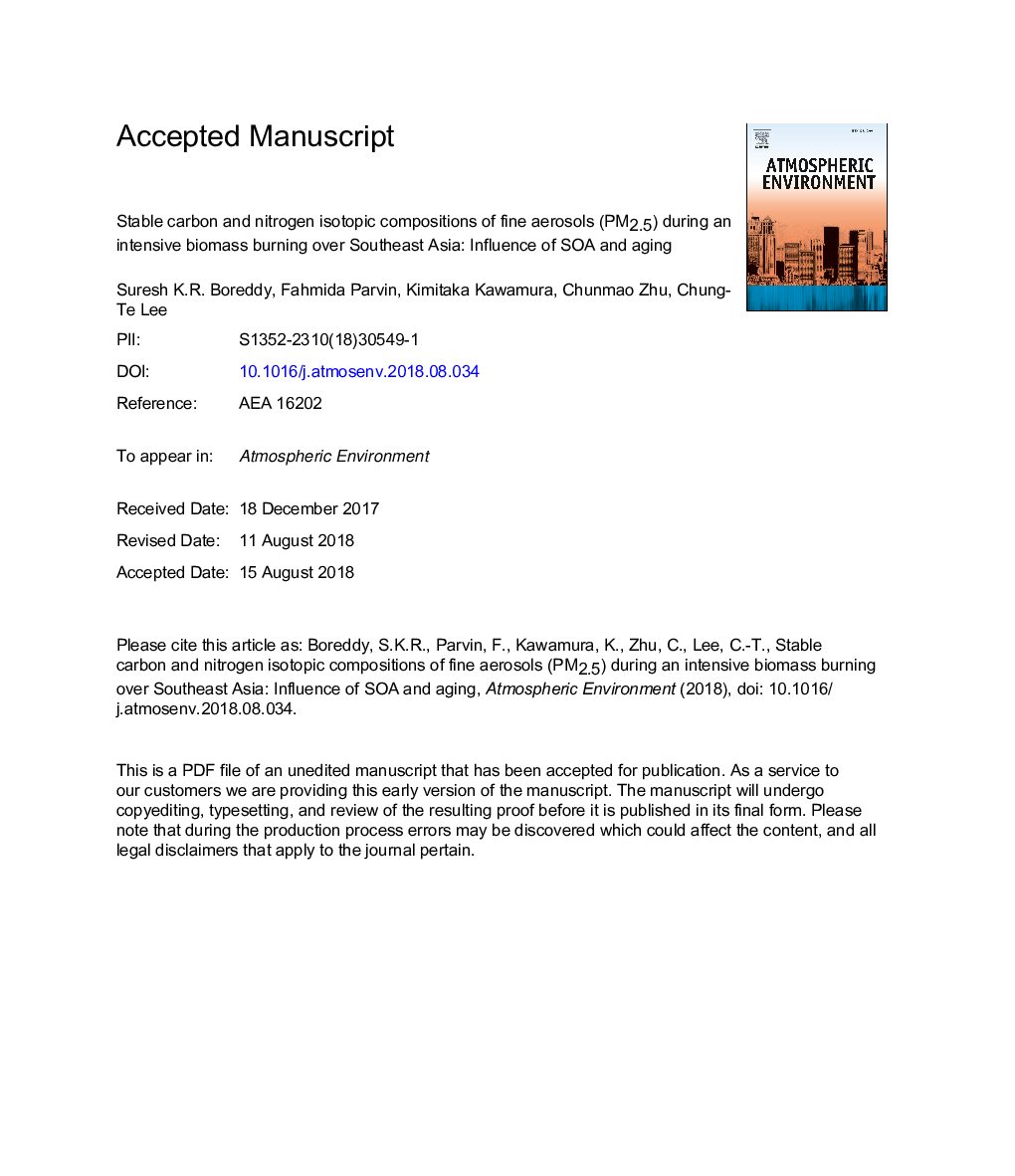| کد مقاله | کد نشریه | سال انتشار | مقاله انگلیسی | نسخه تمام متن |
|---|---|---|---|---|
| 8863444 | 1620283 | 2018 | 29 صفحه PDF | دانلود رایگان |
عنوان انگلیسی مقاله ISI
Stable carbon and nitrogen isotopic compositions of fine aerosols (PM2.5) during an intensive biomass burning over Southeast Asia: Influence of SOA and aging
دانلود مقاله + سفارش ترجمه
دانلود مقاله ISI انگلیسی
رایگان برای ایرانیان
کلمات کلیدی
موضوعات مرتبط
مهندسی و علوم پایه
علوم زمین و سیارات
علم هواشناسی
پیش نمایش صفحه اول مقاله

چکیده انگلیسی
The present study reports on total carbon (TC) and nitrogen (TN) and their isotope ratios in PM2.5 (particulate matterâ¯â¤â¯2.5â¯Î¼m in aerodynamic diameter) collected at Dai Ang Khang (DAK; 19.93°N, 99.05°E; 1518â¯m above sea level), Thailand, during March 1 to April 13, 2015, when biomass-burning (BB) was intense in Southeast Asia (SEA), particularly in Myanmar. Concentrations of TC and TN varied from 1.4 to 80â¯Î¼gC mâ3 (mean: 33.8â¯Â±â¯21.7â¯Î¼gC mâ3) and 0.7 to 8.6â¯Î¼gN mâ3 (3.0â¯Â±â¯1.6â¯Î¼gN mâ3), respectively. Temporal variations of TC and TN largely increased from the start of the campaign to March 21 and decreased during March 22-28 and then slightly increased during the period of March 28-April 13. This temporal pattern was consistent with variations of levoglucosan (LG, specific tracer of biomass burning) and MODIS (moderate resolution imaging spectroradiometer)-derived fire spots in SEA, suggesting that BB emissions are major sources of PM2.5 aerosols at DAK. This inference was further supported by higher TC/TN ratios (range: 6-19, mean: 12.7â¯Â±â¯3.3) and significantly strong positive correlations among TC, TN, and LG during the campaign period. On the other hand, stable isotope ratios of total carbon (δ13CTC) and nitrogen (δ15NTN) in PM2.5 ranged during the sampling period from â23.8 to â29.8â° (â26.0 ± 1.2â°) and from +15.8 to +25.1â° (19.4 ± 2.1â°), respectively. The estimated contribution from the burning of C3 plants to TC ranged between 60 and 96% (average, 74â¯Â±â¯7%) in SEA, indicating the predominance of BB from forest fires. Interestingly, lower δ13CTC values were associated with higher contribution of C3 plants, suggesting that primary aerosols derived from the burning of C3 plants caused a depletion of 13CTC, whereas photochemical aging of organic aerosols may have enhanced δ13CTC, particularly in the second half of the campaign. In addition, changes in meteorological conditions and MODIS fire events may also have caused the changes in δ13CTC during the campaign period. The δ13CTC values reported in this study represent the typical BB aerosols. Our findings improve the fundamental understanding of the sources and transformation processes of atmospheric aerosols in SEA and its outflow regions.
ناشر
Database: Elsevier - ScienceDirect (ساینس دایرکت)
Journal: Atmospheric Environment - Volume 191, October 2018, Pages 478-489
Journal: Atmospheric Environment - Volume 191, October 2018, Pages 478-489
نویسندگان
Suresh K.R. Boreddy, Fahmida Parvin, Kimitaka Kawamura, Chunmao Zhu, Chung-Te Lee,